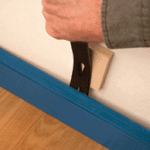Learn how to repair interior woodwork and trim with this expert how-to guide, which covers natural ‘drying’ oils, wax, polyurethane and varnish.
Repairing scratches, cracks, dings, and similar problems with wood trim and other woodwork is easy in most cases. One of the reasons wood is the most popular building material is the fact that it’s easy to machine and work with standard tools. Minor scratches and gouges can be hidden or covered up, but you may want to replace pieces that are more seriously damaged. To protect your interior woodwork, it’s important to keep surfaces clean.
How to Clean Interior Woodwork & Trim
Interior woodwork is usually protected with some kind of clear finish. To clean any wood effectively without ruining the topcoat, you need to know what it was finished with in the first place. Here’s a quick primer on finishes and how to clean them:
Natural “drying” oils like linseed and tung oil soak into the wood surface and then dry hard to form a protective film that is all but invisible. Manufacturers recommend lemon oil polish, which partially dissolves the old topcoat. As you wipe it on, you also wipe away surface grime that has become embedded in the finish.
Wax imparts a surface coating that can be felt and seen. It doesn’t dry as hard as oils and builds up in the wood pores after repeated applications. To clean waxed wood, you can use a commercial wax stripper, a mild solution of white vinegar and water, or lemon oil polish, but you’ll have to reapply a new wax topcoat afterward.
Polyurethane & varnish are basically the same, the only difference being that one is made with plastic resins and the other with natural resins. Both create a hard, waterproof coating that is impervious to most dirt and stains. Woodwork wearing these protective finishes may not look “natural,” but it can be cleaned by simply wiping with a damp cloth.
See the following pages for information on how to repair interior woodwork and trim.






 Don Vandervort writes or edits every article at HomeTips. Don has:
Don Vandervort writes or edits every article at HomeTips. Don has:



